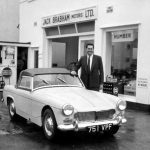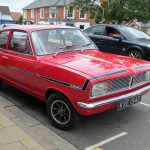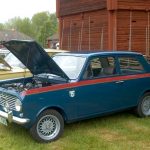SIR JACK BRABHAM – NOT JUST AN F1 DOUBLE WORLD CHAMPION!
STEVE HOLE looks at the career of one of his favourite F1 drivers Sir Jack Brabham outside of Formula One
The racing career of Jack Brabham has been well – and in some cases – excellently documented. What isn’t so well-known is his outside automotive business activities so we thought it was time to round them all up
Born in Australia in 1926, Jack Brabham won three F1 world championships in 1959, 1960 and 1966 and is still the only driver to win a world championship in a car bearing his own name and incidentally, the first racing driver to be knighted (1979).

There were quite few divisions within Sir Jack Brabham’s business empire including Jack Brabham (Worcester Park), which was his Vauxhall dealership. I realise that this image highlights the separate Jack Brabham Motors!
Brabham joined forces with his fellow Aussie, Ron Tauranac, who joined him in England in 1959 initially to help at Jack’s garage in Chessington, although their plan had always been to build their own Formula Junior cars.
They set up Motor Racing Developments to build the cars, although well-known motorsport journalist of the day, Jabby Crombac told them that ‘MRD’ sounded like the French word for sh*t – merde’!
Once this was pointed out to Jack, he and Ron agreed on the trading name Brabham Racing Developments instead.
Brabham later created the Brabham Racing Organisation which was his F1 team and was effectively a customer of BRD. What isn’t so well-documented however is that the holding company remained as MRD and BRD and BRA were trading companies.
With the genius designer, Ron Tauranac creating the Brabham racecars, it shouldn’t be forgotten that they sold over 600 cars before Jack sold his shares to Ron in 1970 and Tauranac, in turn, sold out to Bernie Ecclestone in late 1971.
In the fifties, Jack had founded Brabham Motors, trading from a showroom and garage in Hook Road, Chessington and he was a dealer for Rootes Group’s Sunbeam marque, selling Alpines and Sunbeams and also had a dealership for Standard Triumph and then a sub-agency for BMC
It is said that away from the track, Jack was very hands-on with his garage business and it should be remembered that he started out as a mechanic in the Australian Air Force (RAAF) and was also described as a very decent machinist.
I’ve read accounts from some of his former workshop employees, young chaps who could have been overawed at the sight of the F1 great walking into the workshop, that he would put everyone at ease. I’ve seen words like ‘one of the lads’ and ‘very friendly’ and ‘never on his high horse’ written about Sir Jack.
I read one feature from the sixties where a young mechanic said that he was car-less one day and when he found out, Jack not only gave him a lift home but went into his house to meet his parents, which blew their minds, apparently! How cool was that especially as at that time Jack was a double F1 world champion!
Brabham then set up Jack Brabham Conversions, a very interesting division of his empire. They started out by offering engine conversions on the humble Triumph Herald, but Jack used his race contacts and struck a deal not only with Standard Triumph but also with Coventry Climax for a preferential rate on their FWE 1216cc engine.
This conversion was Jack’s idea, he was actively involved in its development and did all the final road testing. If he wasn’t happy, it didn’t get signed off. Simple as that.
The FWE unit was the same spec as that used by Lotus on Type 14 (Elite) and upped the Herald’s performance by 85 per cent. In addition to the engine, customers also got an uprated clutch and brakes while the car was fitted with wider 5.6 x 13in tyres. There was but one option, uprated suspension which most of the 60 cars that were said to have been converted had.
Then in 1960 came tuning packages for the Sunbeam Alpine and Rapier. The adverts of the day proclaimed ‘Champion Performance for your Sunbeam’.
Three stages of tune were available – Stage 1 gave 91bhp and included gas flowed head, valves and springs, Stage 2 added a spiky camshaft and a modified distributor and took power to 98bhp. Finally, stage 3 topped off the conversion with twin Weber carbs and Brabham’s own inlet manifold. Power was quoted at 108bhp. They also offered a twin SU carburettor conversion, too.
From 1962 Jack and Ron based themselves at the warehouse premises of their engine supplier, Repco’s (their operation in the UK was called Repco Brabham) in Victoria Road in Surbiton.
It’s been quoted that Brabham converted as many as 800 Sunbeams (there were also a few MG Midgets and Sprites that also got the Climax FWE transplant) while they built three engines for the works Alpine effort at Le Mans in 1962.
The next Jack Brabham venture was High Performance Exhaust System Ltd, which sold complete exhausts and also a range of silencers under the ‘Brabham Lukey’ and ‘Big Bore’ silencer names.
The operation was based in Guildford and was a collaboration between Jack and his friend and fellow Australian racing driver Len Lukey (he later sadly died in a crash at Philip Island Circuit in 1978).
They offered exhausts for most British marques, with a particular specialisation in MGB and Mini. I’ve heard it said that they sold lots of these systems. They were quality items, fabricated in 18-gauge aluminium steel and featured no welded parts.
By 1964 Jack had brought all of his very enterprises (except High Performance Exhausts) under one address, a large site close to Brooklands circuit in New Haw, Surrey before they all shifted again to Guildford in 1966.
Later McLaren big wig, Phil Kerr ran Jack Brabham Motors, Mike Puckey was in charge of Jack Brabham Conversions and Brabham and Tauranac themselves were looking after the MRD, BRO and BRD arms.
The Guildford site also has an Esso petrol station attached and downstairs was the machine shop run by the ex-H.R.G ace machinist, Ron Cousins. The famous engineering company founded by Major Edward Halford, Guy Robins and Henry Godfrey in 1935 had a reputation for fine work and counted Brabham and Cooper among their clients.
Until 1956 they also built around 200 sports and racing cars but concentrated on engineering. The company closed its doors for good in 1966 with the rights, patterns, jigs and drawings for their range of upgrade parts like cylinder heads to V.W Derrington in Kingston-upon-Thames although Jack bagged the considerable contents of their machine shop and added Cousins to his employee list.
What isn’t always mentioned in features on Sir Jack Brabham is that he employed future F1 engine great, John Judd at BRO and he was located upstairs at Guildford in charge of the drawing office.
BRABHAM-VIVA
Time, I think, to look at their most high-profile model, Brabham’s Brabham-Viva, which was Jack’s intended rival to the Lotus-Cortina. It was a car that got massive amounts of publicity thanks to Jack’s involvement but sadly didn’t back it up with many sales.
There’s always been stuff written about the car, but much of it was never quite true and it’s certainly a case of when is a Brabham Viva not a Brabham Viva.
Because of the way it was developed and sold, there are many more fakes around than real ones. Plus, of course, there were converted factory-built conversions and those with the performance kit either fitted by the customer’s local Vauxhall dealer or in the garage at home. It all got a bit complicated. The Brabham Viva GT was also built on two generations of Viva, the HA (Mk1) and HB (Mk2) and they were different.
Sir Jack liked a sporty road car and he’d tuned his own Triumph Herald before offering that as a commercial package. Similarly, he had his conversion team carry out some modifications to his own Viva, which he liked, a lot.
A very astute man a pre-knighted Jack (he got the ceremonial tap on the shoulder for Her Majesty in 1979) saw the Viva (he was by then a Vauxhall dealer, too) as a credible alternative to the Mini Cooper and the new Lotus Cortina, as mentioned.
Jack Brabham Conversions with Jack conducting based his package of upgrades on the Viva HA Deluxe model, which meant twin SU carbs, a hand-fabricated exhaust manifold, a free-flow exhaust system, a front anti-roll bar and lowered suspension as standard.
Options included disc brakes all-round, a bespoke binnacle that contained a Smiths rev counter and ammeter, a wood-rimmed steering wheel and matching gearknob and for that finishing touch, if you wanted, three ‘Brabham’ badges and side stripe graphics.
One could also opt for some racing-style but ultimately very uncomfortable, bucket seats, but these could only be filled to a four-door Viva donor, plus you couldn’t adjust the seat back angle.
Leading journalist of the day, John Bolster tested Jack’s demo car, a full-house ‘GTO’ model with all the options and he loved it, saying: “It has sportscar-like performance.”
Vauxhall loved the publicity, but perversely wouldn’t honour warranties on the converted HAs, although proudly claimed in their in-house magazine that some 500 Vivas had been converted to Brabham-Viva GT-spec.
Unfortunately, Sir Jack gave the game away years later when he suggested that 25 sales were closer to the truth. They were quite pricey at £260 more than a Viva Deluxe.
Vauxhall’s numbers could have included the DIY ‘performance’ kits that included the graphics and a few other go-faster parts. This cost just £17.
Jack Brabham Conversions revisited the hot Viva idea once more in 1967, a year after the HB (Mk2) was launched. This is the version that got the company the most publicity.
It was helped greatly by Vauxhall not only honouring warranties this time but selling the cars via selected dealers, too. All Vauxhall dealers could sell you the kit to convert your own car at home.
The HB was slightly more advanced than the HA version and it’s worth pointing out here exactly which model Brabham used for the conversions. You could use the ‘Basic’ model with the 1159cc engine packing 47bhp, which could be turned into the Brabham Viva ‘90’ or ‘90SL’. The latter was more luxurious and had a sportier rear axle ratio.
The SL90 or Deluxe had a better Stromberg 150CD carburettor, a 4-into-1 exhaust manifold and most important of all a higher lift camshaft and a higher compression ratio of 9:1 rather than the 8.5:1 of the ‘Basic’ and ‘Estate’ models.
The rear axle ratio was also altered at the Brabham factory – 4.125:1 rather than the standard 3.89:1 and this was important for Brabham Viva use as the engine spun more freely.
The typical Brabham customer usually went for the extra carb, stripes set and possibly the steering wheel and gearknob. Very few went for the full-house GTO.
Brabham’s stage one DIY kit cost £37.50 and added an extra Stromberg carb, new manifold and free-flow exhaust. Once completed your engine had 69bhp.
If you went for what Brabham called stage two this had 78bhp and featured a modified cylinder head and cost £29.50 on exchange.
If you wanted the fully built ‘Brabham’ Brabham-Viva this was built by Jack Brabham Conversions and cost £730 (£7895 allowing for inflation in 2023) for a 90 or £775 (equivalent to £8382) for a 90SL.
Extras could include bigger wheels for £10.50 (exchange), an oil cooler at £13.50, a wood rim steering wheel with a Brabham badge at £8, the binnacle rev and ammeter gauges at £12 and Koni dampers at £20 a set.
Those love ‘em or hate ‘em bucket seats, first used on the HA conversion in 1963, were available but they cost an eye-opening £31.80 each but did include an inertia seatbelt built into them but adjustment issues remained
Other options included having your engine balanced by Jack’s friend Frank Hallam at Repco Engines in Maidstone as well as having lowered suspension fitted.
If you didn’t choose the ‘Brabham’ graphics for your Brabham-Viva HB the only tell-tale difference was a rorty note courtesy of the straight-thru exhaust.
I’m pretty certain though that most customers would have wanted other road users to know that they were driving a Brabham-Viva, as Jack and his team were pretty high-profile back in the sixties.
The car definitely appealed to stringback glove men of the day, who shopped at John Collier or Hepworths for their blue blazers and polyester grey slacks.
Other road tests I’ve read from the period describe the 78bhp motor as doing nothing below 3000rpm, although I believe that to be true of the Viva HB in SL 60bhp form, too.
It did come on strong though between 4000-6500rpm but it was described as having a bumpy, jarring ride with a jittery throttle that made pulling away a bit of a task.
However, roadholding and overall handling were said to be very good. Mind you, Hot Car’s fuel figures of 20mpg weren’t very good.
By 1967 Jack Brabham Conversions had moved to Woking, Surrey.
As mentioned, there are plenty of fakes around which is fine if you know that before you buy. A half-decent Viva HB could cost around £1200 whereas a genuine Brabham-Viva could be four or five times that, depending on the options and whether it was factory built or a DIY conversion.
It is hard to prove authenticity though as most parts used in the conversion are readily available on the likes of eBay.
Proving that the car is genuine Brabham isn’t helped because the Viva HB’s front wings rusted for fun so even if the customer ordered the side graphics, they will almost certainly have gone due to the wings being replaced.
For the record, cars painted in dark colours would have white stripes and light-coloured examples had black stripes. The original graphics were one-piece, whereas eBay reproductions are always split.
Then, of course, there’s the engine. The HB (of which nearly 650,000 were sold during its nine-year lifetime), didn’t have the 1256cc engine fitted as that came with the HC of 1971. If your Brabham Viva has a 1256cc it didn’t leave the factory with it. Those units always had a red-painted block, by the way.
Brabham-Viva production ceased with the end of HB production in the autumn of 1971.
Be aware too that wooden steering wheels and gearknobs are easy to find, while some people just gave their standard 1159cc engine a twin Stromberg conversion.
When it comes to production figures, it is very hard to say how many Brabham-Vivas were sold. A marque expert told me at the Classic Car show that it was ‘more than 100’ but ‘less than 200’.
These days genuine Brabham-Viva are hard to find. The same expert I spoke to reckons less than ten are on the road in the UK. However, Brabham’s conversion still looks great and suits the classic Coke-bottle shape of the HB very well, possibly because it was 7in longer than the HA.
A genuine child of its time.
| Print article | This entry was posted by admin on February 2, 2023 at 7:24 pm, and is filed under Uncategorized. Follow any responses to this post through RSS 2.0. Both comments and pings are currently closed. |
Comments are closed.


















